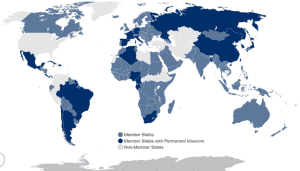TAG: GS 2: INTERNATIONAL RELATIONS
THE CONTEXT: A new maritime dispute has emerged between India and Sri Lanka over the exploration rights for cobalt-rich ferromanganese crusts in the Afanasy Nikitin Seamount, located in the Indian Ocean.
EXPLANATION:
- The International Seabed Authority (ISA), based in Kingston, Jamaica, is at the center of this dispute, as Sri Lanka has objected to India’s application for exploration rights in this region.
- This conflict is intricately tied to broader geopolitical and environmental issues, reflecting the complex dynamics of international maritime claims and resource exploration.
Background
- Afanasy Nikitin Seamount
- The Afanasy Nikitin Seamount is a substantial undersea mountain range in the equatorial Indian Ocean.
- It stretches 400 kilometers in length and 150 kilometers in width, with a main plateau rising 1,200 meters above the surrounding ocean floor at a depth of 4,800 meters.
- The area is rich in cobalt-rich ferromanganese crusts, making it a significant target for mineral exploration.
- India’s Application to the ISA
- On January 18, 2024, the Earth System Science Organization (ESSO), an autonomous body under the Ministry of Earth Sciences of the Indian government, submitted an application to the ISA seeking approval for a 15-year exploration plan.
- This application includes a fee of $500,000 and aims to explore a 3,000 sq. km area divided into 150 blocks, none exceeding 20 sq. km, organized into six clusters.
Sri Lanka’s Objection
- Sri Lanka has urged the ISA to withhold India’s exploration application until the United Nations Commission on the Limits of the Continental Shelf (UN-CLCS) decides on Sri Lanka’s continental shelf claim.
- Colombo asserts that the Afanasy Nikitin Seamount falls within its extended continental shelf, a claim that has been pending with the UN-CLCS since 2009.
- This claim is in direct contradiction to India’s own continental shelf claims, and bilateral negotiations over the past 15 years have failed to resolve this impasse.
- The Sri Lankan government has stated that the ISA is adhering to applicable procedures regarding this matter, and the situation remains ongoing.
- The Sri Lankan Ministry of Foreign Affairs has emphasized the need for the ISA to await the UN-CLCS decision before proceeding with India’s exploration request.
Geopolitical Context
- India’s push for exploration rights in the Afanasy Nikitin Seamount is partly driven by strategic considerations, particularly the increasing presence of Chinese research vessels in the Indian Ocean.
- By securing exploration rights, India aims to counterbalance China’s growing influence in the region.
- The timing of the dispute also intersects with domestic political developments in India.
- The recent parliamentary elections saw the ruling Bharatiya Janata Party (BJP) rekindle the controversy over Katchatheevu Island, blaming opposition parties for ceding the island to Sri Lanka and compromising the interests of Tamil Nadu fishermen.
- This renewed focus on maritime issues underscores the broader geopolitical stakes for New Delhi.
Environmental and Economic Implications
- Resource Potential
- The exploration of cobalt-rich ferromanganese crusts holds significant economic potential due to the critical role of cobalt in modern technologies, including batteries for electric vehicles and renewable energy storage.
- The successful exploration and subsequent extraction could provide substantial economic benefits.
- Environmental Concerns
- However, the environmental impact of deep-sea mining is a major concern.
- The unique ecosystems around seamounts are vulnerable to disturbances from mining activities.
- This aspect adds another layer of complexity to the dispute, highlighting the need for careful consideration of environmental consequences.
International Seabed Authority (ISA):
- It is an intergovernmental body of 168 member states and the European Union established under the 1982 UN Convention on the Law of the Sea (UNCLOS) and its 1994 Agreement on Implementation.
- The ISA’s dual mission is to authorize and control development of mineral related operations in the international seabed considered the “common heritage of all mankind and also protect the ecosystem of the seabed, ocean floor and subsoil in “The Area” beyond national jurisdiction.
- The ISA is to safeguard the international deep sea, the waters below 200 meters or 656 feet, where photosynthesis is hampered by inadequate light Governing approximately half of the total area of the world’s oceans, the ISA is to exercise oversight of activities that might threaten biological diversity and harm the marine environment.
- The Authority operates as an autonomous international organization with its own Assembly, Council and Secretariat.
- India is a members of the International Seabed Authority (ISA).


